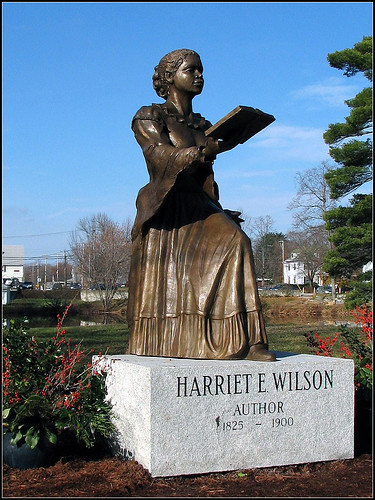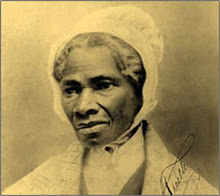 Sojourner's Place is proud to present the first in a series of posts entitled: Ain't I a Woman? A Sojourner's Salute. Each post will present an African-American woman whose greatness and impact was or is largely overlooked by the history books or media. I hope you will find this series to be enlightening, educational, and inspirational in celebration of the lives of African-American women who made and are making a difference.
Sojourner's Place is proud to present the first in a series of posts entitled: Ain't I a Woman? A Sojourner's Salute. Each post will present an African-American woman whose greatness and impact was or is largely overlooked by the history books or media. I hope you will find this series to be enlightening, educational, and inspirational in celebration of the lives of African-American women who made and are making a difference.
Born on March 15, 1825, little was known about Harriet E. Wilson until "discovered" by Henry Louis Gates, Jr. Gates, a Harvard Professor Director of the W. E. B. Du Bois Institute for African and African American Research, authenticated and facilitated the 1983 publication of Our Nig, or, Sketches from the Life of a Free Black (1859), by Harriet E. Wilson. As a result of his "discovery", Wilson is now acknowledged as the first African-American novelist to be published in the United States.
For many years, William Wells Brown was considered to be the first African-American novelist to be published. His book, entitled Clotel: The President's Daughter, although published six years before Wilson's novel, was published in the United Kingdom rather than in the United States. Thereby, anointing Harriet as the recipient of this "first" in American and African American history. An account of the injustices of the indentured servitude system in the North, "Our Nig" fell into obscurity soon after it was published until being rediscovered in 1982. It is widely considered to be an autobiographical account of Wilson's life as the novel coincides with much of what is now known about Harriet's life, as provided by the Harriet Wilson Project:
1825 (March 15): Harriet E. Adams born in Milford, NH
1830 -31: Abandoned by mother at the Nehemiah Hayward family farm
1840 (June 1): Census locates Harriet Adams at the Hayward's 1850: Harriet E. Adams appears as a 22-year-old black woman living with the Boyles on the federal census for Milford
1851 (October 6): Harriet E. Adams marries Thomas Wilson in Milford, NH
1852 (May or June): Harriet E. Wilson gives birth to son George Mason Wilson
1855 – 1859: Harriet Wilson and/or her son appears on the Reports of the Overseers of the Poor for the town of Milford
1859 ( August 18): Harriet Wilson copyrights Our Nig, with a copy deposited in the Office of the Clerk of the U.S. District Court of Massachusetts
1859 (September 5): Our Nig is published by George C. Rand and Avery in Boston
1860 (February 16): Wilson’s son, George Mason Wilson, dies in Milford, ages seven years, eight months
1863: Harriet Wilson appears on the Report of the Overseers of the Poor for the town of Milford
1867: Harriet Wilson listed in the Boston Spiritualist newspaper Banner of Light as living in East Cambridge, Massachusetts. She is known in Spiritualist circles as "the colored medium" 1870 (September 29): Marries John Gallatin Robinson in Boston
1870 - 1897: Mrs. Hattie E. Wilson listed in the Banner of Light as a trance reader and lecturer 1900 (June 28): “Hattie E. Wilson” dies in Quincy Hospital, Massachusetts. She is buried in the Cobb family plot in Mount Wollaston Cemetery in Quincy, plot number 13337, "old section.
"In Harriet's own words, the impetus for writing this novel appears in the Preface.In offering to the public the following pages, the writer confesses her inability to minister to the refined and cultivated, the pleasure supplied by abler pens. It is not for such these crude narrations appear. Deserted by kindred, disabled by failing health, I am forced to some experiment which shall aid me in maintaining myself and child without extinguishing this feeble life. I would not from these motives even palliate slavery at the South, by disclosures of its appurtenances North. My mistress was wholly imbued with southern principles. I do not pretend to divulge every transaction in my own life, which the unprejudiced would declare unfavorable in comparison with treatment of legal bondmen; I have purposely omitted what would most provoke shame in our good anti-slavery friends at home.
My humble position and frank confession of errors will, I hope, shield me from severe criticism. Indeed, defects are so apparent it requires no skilful hand to expose them. I sincerely appeal to my colored brethren universally for patronage, hoping they will not condemn this attempt of their sister to be erudite, but rally around me a faithful band of supporters and defenders. H. E. W.
Literary critic Francis Browne states: "Wilson's art might indeed be defective, but her imaginative effort ... has proven itself worthy and signally prophetic." While Henry Louis Gates argues "... that Wilson is the most accomplished and subtle black novelist of the nineteenth century." I encourage all Sojourner's visiting here to take some time to learn more about this amazing African-American icon - Harriet E. Wilson Project whose purpose to raise awareness her literary work, to educate the public on her contribution to American history and her contribution to American literature, and to publicly honor her for her accomplishments.
Obliged to you for hearing me,
and now old SjP ain't got nothin' more to say...
~~~ ~~~ ~~~
Technorati ~ ~ Del.iciou.us ~ ~ Digg This! ~ ~ StumbleUpon ~ ~ Twitter ~ ~ My Good Towels ~ ~ FeedBlitz ~ ~ Email SjP
Sojourner's Place
5 sojourners hollin' back
My oh my you have a nice blog Thanks for sharing I like this.....Oh, holy Father, by thy power,
Thus far in life I'm brought;
And now in this dark, trying hour,
O God, forsake me not" -
Harriet E. Wilson
This just reminded me that I was going to start writing about books and stop pretending that I only watched television as a child. This is a great piece and Our Nig and Clotel are both very interesting pieces to read, and the commentary they offer for contemporary times are still powerful. (and the greater thing is that both are available for free online. I did not purchase books during my senior year of college!)I dont remember if I completed Our Nig, but the gendered relations (esp. intra-gender) in that book are really interesting when you add it to the poetry of "Ain't I a Woman?" It's a nice little prelude to the issues of racism that beleaguered (wc?) the feminist movement.
Great post!
That was informative.
@ Debbie, much obliged for the "add" and please don't be a stranger here at SjP's. My doors are always open.
@MishKash, Much obliged for your kind and warms words about my little spot. I glad you enjoyed this post on HEW. Don't be a stranger.
@ Kim,much obliged. I've not read Clotel - but I have read HEW's book. One of my prized possessions as I actually received an autographed copy of it directly from HLG. I do agree that it serves as a prelude to the issues of racism that have beleaguered wc in just about all movements.
@ Mike, much obliged.

|

|
Who I Be?

- SjP
One Christian, African-American, Wife, Mother, Daughter, Sister, Professional, Sorority Woman just Sojourning for the Truth and not afraid to tell it!
Welcome to Sojourner’s Place!
Created with the professional African-American woman in mind, the scope of Sojourner’s Place evolves every day. So glad you stopped by and I hope you will be inspired, informed, motivated, and energized!
Once again, welcome and much obliged for stopping by. Come back soon!
SjP
Est. January 1, 2008
Cooking Up on the Stove
The Menu @ SjP's
Round the Kitchen Table
Up in the Attic
SjP's Daily Dose
Coffee & Dessert
- AAO: Discussion Forum
- Afro-Netizen
- Automatic Preference
- Beautiful Are the Souls of Black Sisters
- Bent Society Blog
- Black Agenda Report
- Black Gives Back
- Black News Junkie
- Black Perspective [dot] Net
- Change Therapy
- Diversity Ink
- Hello Beautiful
- Hey Shae!
- I Choose Bliss
- Mimi Writes
- Modern Musings
- Monroe Anderson
- Mothers are Vanishing
- New Black Woman
- PurpleZoe
- Racialicious
- Roots of Humanity
- Sankofa
- Shades of Black and White
- Songs in the Key of Life
- Tell It WOC Speak
- The Black Factor
- The Busy Mind of a Quiet Man
- The Epitome: Dialogues and Discourse
- The Field Negro
- The Root
- Thoughts of a Ghetto Intellectual
- Underground Railroad Tribal Alliance
- Vanessa: Unplugged
- Vibes of Humanity
- What Matters to Believer
- When Least Expected
Global Day of Action for Troy Davis


SjP passes this award on to all Global Blogging Day of Action for Troy Davis Participants.
Today's Word of Knowledge
Find more Motivational Quotes
Home of the Helping Hand Emblem
For My Sistas
'Cause, I Sing America, Too
 The 44 President of the United States
The 44 President of the United States~~~~~
The White House Briefing Room
~~~~~
Your Money at Work? Recovery.Gov
LeKeesha Alert!
 Chioma Gray
Chioma Gray Adji Desir
Adji Desir 













